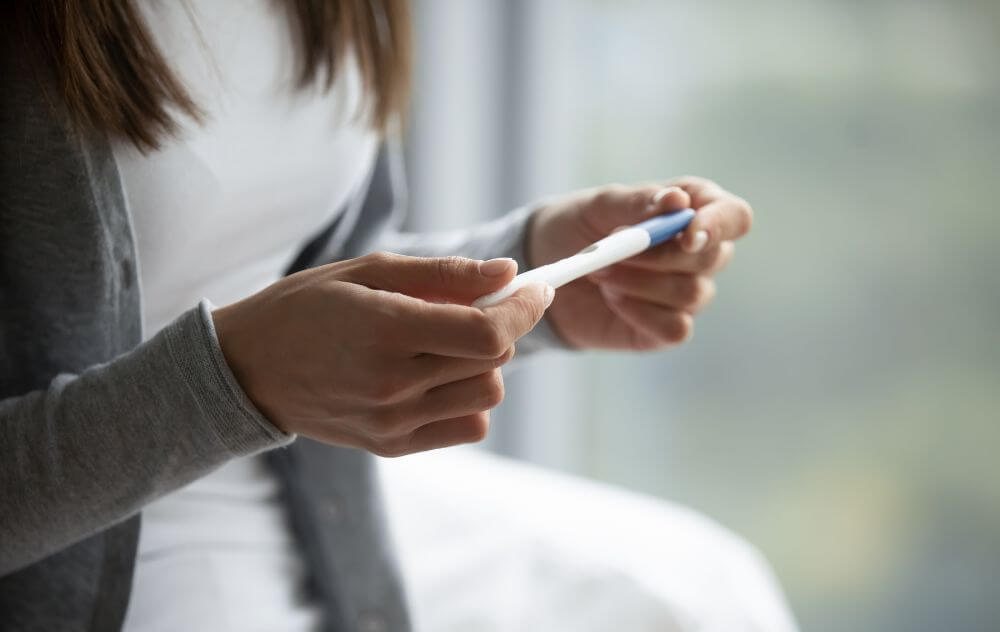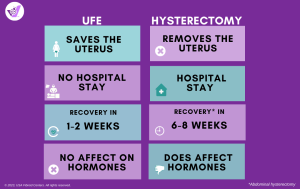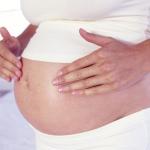
Topics Covered:
- Can Fibroid Removal Cause Infertility?
- Do Fibroids Impact Fertility?
- Fibroid Removal and Pregnancy
- Does Fibroid Removal Affect Pregnancy?
There are a variety of treatment procedures for removing fibroids, both surgical and non-surgical. Whether you can become pregnant after fibroid removal largely depends upon the treatment method used. A hysterectomy, for instance, involves the surgical extraction of the uterus, permanently removing the possibility of becoming pregnant. However, uterine fibroid embolization, a non-surgical treatment, leaves the uterus intact and is unlikely to affect fertility. In this article, we answer questions like “Can fibroid removal cause infertility?” and “Does fibroid removal affect pregnancy?”
Uterine fibroids are growths in the uterus that can cause painful and uncomfortable symptoms, interfering with your daily activities and overall quality of life. Fibroid symptoms include heavy periods, pelvic pain, frequent urination, and fatigue. If you are experiencing any of these symptoms, talk to a doctor to discuss treatment options.

USA Fibroid Centers’ interventional radiologists offer a minimally invasive, non-surgical treatment called uterine fibroid embolization (UFE). This state-of-the-art technique can shrink fibroids and relieve pain and other symptoms while leaving the uterus intact, which preserves fertility. Many women have successfully given birth after UFE treatment.
In fact, it is important to note that UFE does not block the blood supply to the entire uterus, only to the fibroids. In most cases, the uterus is able to compensate for the reduced blood flow and remains fertile.
However, here are a few reasons why some women may experience infertility after fibroid removal such as a myomectomy. One possibility is that the fibroids were located near or around the fallopian tubes or ovaries, and the surgery to remove them damaged these organs. Another possibility is that the surgery caused scarring, which can also interfere with fertility.
Not all women can wait until after their childbearing years to seek treatment for uterine fibroids. If you need help with fibroid symptoms now but want to retain your fertility and avoid fibroid removal surgery, UFE may be a good option.
Talk to one of our leading fibroid specialists today to learn more about UFE fibroid removal and how it can help you achieve your fertility goals.
Can Fibroid Removal Cause Infertility?

Some fibroid removal treatments affect fertility. Many women’s primary concern when seeking fibroid treatment is whether fibroid removal causes infertility. It is understandable to be concerned about your ability to become pregnant. If you have avoided seeing a doctor due to the fear that all fibroid treatment causes infertility, there is hope.
A hysterectomy will always lead to infertility, as it removes the uterus and thus the woman’s ability to carry a child. However, other treatments, such as uterine fibroid embolization (UFE), are less likely to affect fertility.
If you hope to become pregnant after fibroid treatment, discuss your plans with your doctor. They can help you understand the risks and benefits of each procedure to ensure you make the best decision for your future.
Do Fibroids Impact Fertility?
In some cases, fibroids can make it difficult for a woman to get pregnant. About five to ten percent of women with infertility have fibroids, though the size and location of these fibroids are factors in determining whether they are causing infertility. For some women, fibroid treatment may increase their chances of becoming pregnant.
Fibroids can impact fertility in many ways:
- They can change the shape and lining of the uterus and impact certain biochemical processes within the uterus. This can make it difficult for the fertilized egg to implant in the uterine wall.
- Fibroids can change the shape of the cervix, affecting the movement and number of sperm that can enter the uterus.
- They can grow in the fallopian tubes or block blood flow, preventing the egg from being fertilized.
At USA Fibroid Centers, we believe UFE is the best option for most women who want to get pregnant after treatment. We recommend consulting one of our experienced fibroid specialists to discuss your needs.
Fibroid Removal and Pregnancy
If you are considering fibroid removal, you should know how each procedure will affect your ability to become pregnant. A fibroid specialist can help you make the best choice based on the size, number, and location of your fibroid(s), as well as your age and desire to become pregnant.
Uterine fibroid removal treatments include:
Uterine Fibroid Embolization (UFE)
UFE is considered the gold standard of fibroid treatment for women who want to preserve their uterus and fertility. Fibroid embolization is a minimally invasive procedure that can reduce or eliminate fibroid symptoms without surgery. It is performed under light sedation and takes only 30–45 minutes, depending on the number of fibroids treated.
During the UFE procedure, a small catheter is inserted into your wrist or upper thigh area. Using real-time imaging, the catheter is guided to the main uterine artery that feeds the fibroid(s). Safe, tiny particles are then injected into the artery, blocking the fibroid’s blood supply and causing the fibroid to wither and eventually die. Since embolic materials remain permanently at the fibroid site, UFE-treated fibroids are unlikely to regrow.
Unlike fibroid surgeries, uterine fibroid embolization leaves the uterus in place and intact. This means you can still get pregnant and have a baby after UFE.
Additionally, UFE is safer and has a faster recovery than fibroid surgery. You will not need general anesthesia or stitches; you can go home on the same day as your treatment. Most women resume their normal daily activities within one to two weeks.
At USA Fibroid Centers, we are proud to share that our UFE treatment has a 99 percent success rate. To learn more about fibroid embolization and how it affects fertility, schedule a consultation with one of our specialists today.
Hysterectomy
Hysterectomy is a surgery to remove the uterus. It is a permanent treatment for fibroid removal, but it has drawbacks- especially when compared to less invasive methods, such as uterine fibroid embolization.

Removes the Uterus. One of the most significant drawbacks of a hysterectomy is the permanent removal of the uterus, causing immediate sterility. This is a crucial consideration for women who want to have children in the future.
Hospital Stay. A hysterectomy is a major surgery that requires a hospital stay and a lengthy recovery period. After the surgery, women may experience pain, fatigue, and other side effects, making it difficult to return to their normal activities. After a hysterectomy, women typically stay in the hospital for two or three days for monitoring and pain management. Once discharged from the hospital, they need to continue to rest.
Recovery 6 – 8 Weeks. The recovery period for an abdominal hysterectomy can last anywhere from six to eight weeks. Women should avoid lifting heavy objects, driving, and strenuous activity while recovering, and they may need to adjust their diet and lifestyle to support their healing bodies.
Affects Hormones. Another drawback of a hysterectomy is that it may cause early menopause. If the ovaries are removed during the surgery, the woman no longer produces estrogen and progesterone, the hormones that regulate the menstrual cycle. Research tells us that even women who have undergone hysterectomies without the removal of the ovaries are at high risk of early menopause. Early menopause means the early onset of menopausal symptoms such as hot flashes, night sweats, mood changes, weight gain, and increased risk of heart disease and osteoporosis.
It is important to remember that while every woman’s recovery experience is different, a hysterectomy for fibroid removal involves more risk than UFE and other nonsurgical techniques. Risks from surgery include infection, excessive bleeding, blood clots, and adverse reactions to anesthesia.
Myomectomy
Myomectomy is a surgery to remove fibroids from the uterus. Unlike a hysterectomy, a myomectomy leaves the uterus intact. There are three types of myomectomy: abdominal, laparoscopic, and hysteroscopic. The type of myomectomy performed depends on the size and location of the fibroids. However, it’s important to note that scarring can occur as a result of myomectomy. Additionally, in some cases, myomectomy may leave some fibroids behind, which can cause symptoms later.
Recovery time varies by surgery. An abdominal myomectomy typically requires the longest recovery time of up to six weeks.
Fibroids can return after myomectomy surgery. The younger you are at the time of treatment, the more likely this is to occur.
USA Fibroid Centers ambassador Shay Johnson talks about the impact her myomectomy had on her life in this video about fibroid sizes.
Although pregnancy is often possible after myomectomy, your success depends on your age, size, location, number of fibroids, and other underlying health conditions.
Acessa™ Procedure
The Acessa™ procedure is a minimally invasive surgery that uses radiofrequency ablation to treat fibroids. During this procedure, a surgeon makes two small incisions in the abdomen and inserts a laparoscope (a thin tube with a small camera and high-intensity light) to view the inside of the abdomen. The surgeon then uses a handpiece that emits focused heat to destroy the targeted fibroid tissue.
The Acessa™ procedure uses radiofrequency ablation instead of cutting out the fibroids. The Acessa™ procedure is generally not recommended for large fibroids, but it can be a good option for women who want to keep their uterus.
This is a relatively new treatment, so data about its impact on fertility is minimal. UFE is a more established treatment that is safe for women who want to get pregnant. If you are considering treatment for fibroids and want to preserve your fertility, UFE is likely a better option.
Medications
Medications can help manage fibroid symptoms. However, they do not result in uterine fibroid removal. Birth control pills and devices may help to control heavy fibroid bleeding, while pain medications can manage menstrual cramps and back pain due to fibroids. However, medication alone is unable to treat fibroids.
Does Fibroid Removal Affect Pregnancy?

Along with their potential impact on a woman’s ability to get pregnant, some fibroid removal methods can also affect the course of a pregnancy. For instance, women who have had a myomectomy may need a C-section to reduce the risk of the uterus rupturing during delivery. Therefore, the risk of pregnancy complications is another consideration when choosing a fibroid treatment.
A fibroid specialist can evaluate the size, number, and location of your fibroids to make a personalized treatment recommendation that will minimize your pregnancy-related risks.
GETTING PREGNANT WITH FIBROIDS
Schedule a Consultation at USA Fibroid Centers
Fibroid removal and pregnancy can be stressful topics. We want to help you find the best available fibroid removal treatment option that accommodates your desire to have a baby. Our doctors are compassionate and understanding. They will discuss your treatment options and help you make the best decision based on your circumstances.
USA Fibroid Centers specialize in uterine fibroid embolization, a minimally invasive, office-based treatment that can shrink fibroids, eliminate symptoms, and preserve fertility. Many of our patients have enjoyed successful pregnancies after UFE.
If you are interested in uterine fibroid removal and pregnancy, please call us at 855.615.2555 or schedule an appointment online. We offer dozens of treatment center locations nationwide and convenient telemedicine options. There is no need to suffer from symptomatic fibroids, especially if you plan to become pregnant.



